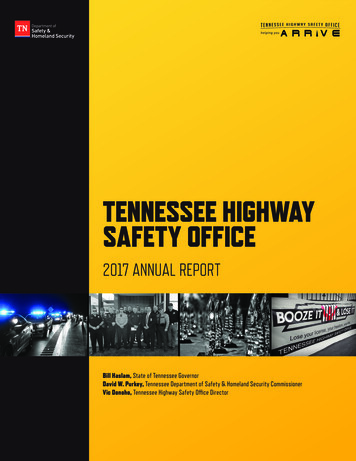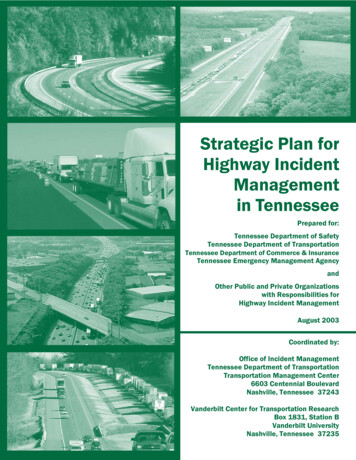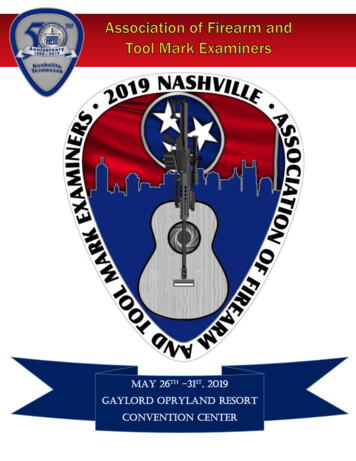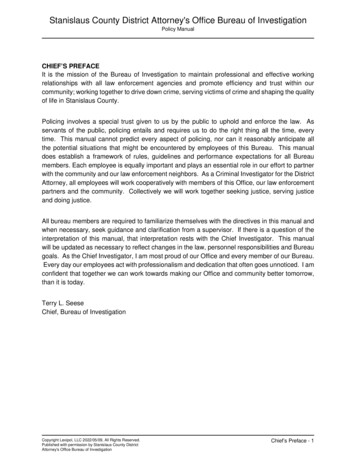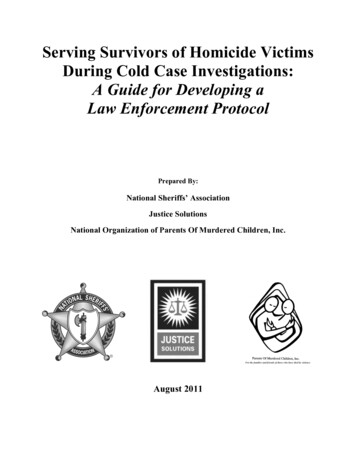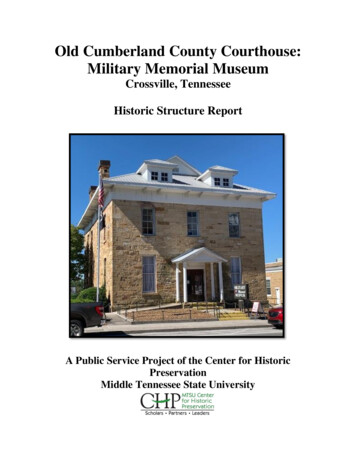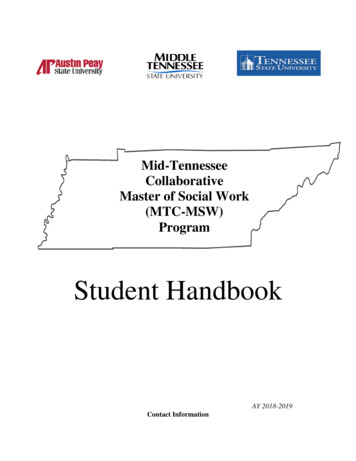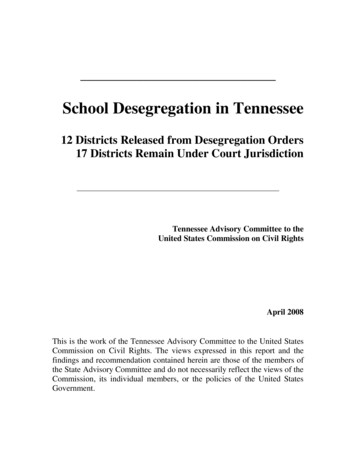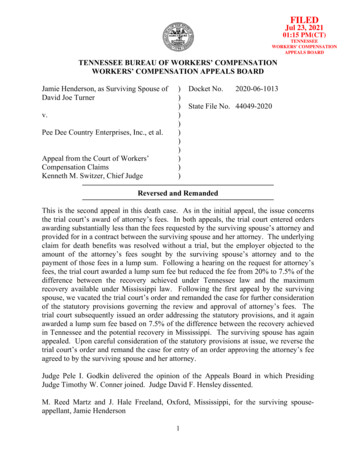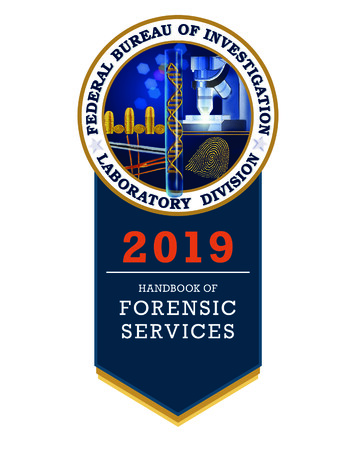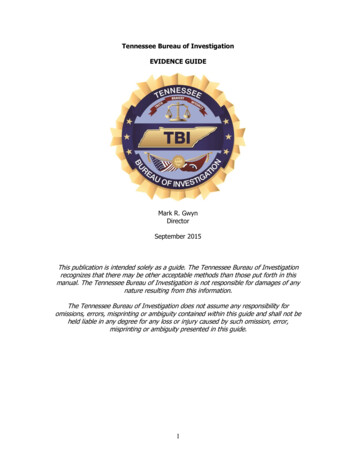
Transcription
Tennessee Bureau of InvestigationEVIDENCE GUIDEMark R. GwynDirectorSeptember 2015This publication is intended solely as a guide. The Tennessee Bureau of Investigationrecognizes that there may be other acceptable methods than those put forth in thismanual. The Tennessee Bureau of Investigation is not responsible for damages of anynature resulting from this information.The Tennessee Bureau of Investigation does not assume any responsibility foromissions, errors, misprinting or ambiguity contained within this guide and shall not beheld liable in any degree for any loss or injury caused by such omission, error,misprinting or ambiguity presented in this guide.1
Table of ContentsSPECIAL NOTICESWhere to Submit EvidenceViolent Crime Response Team ProgramTBI Evidence Receiving UnitHow to Submit EvidenceForensic Biology UnitBlood, Semen, Saliva, DNAFirearm and Toolmark Identification UnitFirearms, Toolmarks, IBISForensic Chemistry UnitControlled SubstancesLatent Print UnitLatent Prints, AFISMicroanalysis UnitFibers, Arson, Paint, Gunshot Residue,Physical Matches, Footwear & Tread Impressions,Explosive Analysis, and other “Trace” EvidenceToxicology UnitDrugs & Blood Alcohol Samples2
SPECIAL NOTICE**Accreditation**When submitting evidence to the TBI Laboratory, submitters acknowledge the following:-TBI Examiners will choose appropriate technical processes to address thesubmitter’s request for examination.-Depending on the caseload of the laboratory and the needs of the customer,evidence examinations may be contracted and/or subcontracted to anotherlaboratory.-A TBI Laboratory Report of Examination may contain the opinions and/or theinterpretations of the examiner(s) who issued the report.Evidence SealsAll evidence submitted to a Tennessee Bureau of Investigation Crime Laboratory mustbe in a container that is sealed. The only seals that will be accepted are:-Tape running the entire width of the opening of the packageHeat-sealed packagesPackages with Tamper-proof SealsAll evidence seals must be initialed by the person sealing the package or placing a sealon the package.If you are sealing the package with tape, the initials, date and time should overlap thetaped seal and the package – so that your markings are on both.For tamper-proof packages, the initials must be on the seal. For heat-sealed packages,the initials must be as close as possible to the seal.Evidence that does not meet the sealing requirements cannot be accepted foranalysis by a Tennessee Bureau of Investigation Crime Laboratory.If it is not practical to package a piece of evidence (such as, an entire vehicle), theofficer or technician submitting that evidence should securely attach a tag to theevidence and initial the tag.All evidence containers/packages must be sealed to the extent that nothing can beadded to or removed from the container/package.3
General Evidence Collection SuppliesGeneral Evidence Collection Supplies include, but are not limited to:Biohazard bags and containersCamera and accessoriesComplete fingerprint kit including: lift tape, cards, brushes, and powderCotton swabsCotton work glovesCoverallsCrime scene tapeDirectional compassDisassembly toolsDrywall knifeDust masksEnvelopes (small, large, business, 9” x 12” manila)Evidence sealing tapeBox of flaresFlashlight and extra batteriesGraph paperLegal-sized clipboardLocation markersMagnifying glassMeasuring tapeMylar, clear sheets (8 ½” x 10”)Paper bags and cardboard boxes (small, medium, large)Pens, pencils, and permanent markersPocket knife (multi-tool)Protective footwearProtective glasses (safety glasses)Roll of cotton battingRoll of stringRubber glovesSawsScissorsSmall and large trash bagsSmall shovelStapler and staplesTapeTrajectory RodsUnused paint cansZiploc bags4
Where to Submit Evidence and Services OfferedSubmit Evidence to the Laboratory Serving Your Area:Nashville Crime Laboratory901 R.S. Gass Blvd.Nashville, Tennessee 37216-2639Special Agent, Forensic Scientist Mike Lyttle, Regional Crime Laboratory Supervisor(615)744-4488Firearm and Toolmark Identification, Forensic Chemistry, Latent Prints, Microanalysis,Forensic Biology, Toxicology, Breath AlcoholKnoxville Crime Laboratory1791 Neals Commerce LaneKnoxville, Tennessee 37914Special Agent, Forensic Scientist Kelvin Woodby, Regional Crime Laboratory Supervisor(865) 549-7870Forensic Chemistry, Forensic Biology, Toxicology, Breath AlcoholMemphis Crime Laboratory6325 Haley RoadMemphis, Tennessee 38134Special Agent, Forensic Scientist Donna Nelson, Regional Crime Laboratory Supervisor(901) 379-3457Firearm and Toolmark Identification, Forensic Chemistry, Forensic Biology, Toxicology,Breath AlcoholShould you have a question about which laboratory handles your evidence, please callany of the above laboratories for assistance prior to submission of the evidence.5
TBI Violent Crime Response Team ProgramQuestions that will be asked prior to dispatching the TBI Violent CrimeResponse Team:-Is it a homicide crime scene?Has the crime scene been preserved and secured?Has any processing already been performed?What processing is needed?What are the reasons for needing a crime scene team?Have you contacted the TBI Agent assigned to your county?Each time the Violent Crime Response Team is dispatched to a crime scene, valuablelaboratory analysis time is lost. Therefore, the Violent Crime Response Team can onlyrespond to the most violent, heinous homicide crime scenes in the state.Recommended steps for preserving the Crime SceneIt is recommended that the following measures be taken as soon as possible:--Tape off a generous perimeter and post officers to provide security for thescene.Begin a Perimeter Log requiring anyone who enters the Crime Scene torecord the following information: Name Rank Date Time In Time Out PurposeLimit access to the absolute minimum people, for example: Don’t unnecessarily walk through the crime scene. Don’t smoke, eat or drink within the crime scene. Don’t use the bathroom facilities within the crime scene. Don’t use the telephone within the crime scene. Don’t allow items to be removed from the crime scene.6
TBI Violent Crime Response Team ProgramEach Violent Crime Response Team consists of Forensic Specialists with expertise inLatent Prints, Firearm & Toolmark Identification, Forensic Biology and Microanalysis.This Team has access to a specially designed and outfitted vehicle containing allnecessary supplies and equipment for safe and thorough crime scene processing.Recommended steps for preserving the Crime Scene:It is recommended that the following measures be taken as soon as possible:A. Tape off a generous perimeter and post Officers to provide security for thescene.B. Begin a Perimeter Log requiring anyone who enters the Crime Scene torecord the following information:1. Name2. Rank3. Date4. Time In5. Time Out6. PurposeC. Limit access to the absolute minimum possible.Once the decision to utilize the Violent Crime Response Team has been approved, acertain amount of time will be required for the Team to respond. (This includesnotification of Team Members, travel time to the assembly point, assembling allnecessary gear and equipment, and travel time to the Crime Scene.)During this time interval, should the Investigator at the Crime Scene feel that transientphysical evidence is in jeopardy due to: wind, rain, temperature change, etc., theseconditions may require the Investigator to take steps to protect the integrity of theevidence.In this event, it is recommended that the Investigator contact the Leader of the ViolentCrime Response Team who will give his or her recommendation as to the most effectiveway to protect the evidence until the Team arrives.Please call the Tennessee Information Enforcement System NetworkOperation Center (T.I.E.S.N.O.C.) at (615) 744-4600 for assistance.7
Capabilities of TBI Violent Crime Response TeamGeneral: Documentation of the Crime SceneA. Notes:The VCRT will produce a detailed narrative of all activities fromthe time they are first contacted until they have secured the evidence in theCrime Laboratory. These notes may include, such details as:1. Weather, temperature, lighting2. Verbal description of the scene and as many details as possible regardingit3. Chronology and detailed account of all activities conducted by the Team4. Results of Vehicle Inventory Searches5. Results of Inventory Search of Victim’s clothing and personal effectsB. Videotape: Team will typically produce a detailed video portrayal of:1. The general location and exterior of the Crime Scene2. Areas of possible entry and exit3. Each room of the residence and its contents4. In-depth documentation of the victim, his/her position, wounds, etc.5. All items of evidence as they appeared when located, complete withmarker number and scaleC. Photography: Team will typically produce a detailed digital portrayal of:1. Location Photos – an overlapping series of photos depicting the overallscene, residence, or terrain2. Witness Photos – Long to intermediate range photos depicting areas ofpossible entry and exit, all rooms from multiple angles, victim frommultiple angles, photos from witnesses vantage point, photos showingspatial relationships of items of evidence to one another and to victim,etc.3. Close-ups – Photos depicting wounds, gags, ligatures, etc.4. Evidence Photos – Close range photos depicting each item of evidence asit appeared when located, complete with marker number and scale in theframe5. Other – Available light, painting with light, laser photography, and otherspecial techniques as requiredD. Measuring: The dimensions of the residence and its rooms, as well as, thedistances between any landmarks within the scene, will typically be recorded.Each significant item within the Crime Scene will typically be measured to aminimum of two fixed, permanent reference points (if none are available, theTeam will create suitable reference points). The height of any item ofevidence other than 0” will typically be recorded. Measurements will be madeusing at least one of the following methods:1. Triangulation method2. Rectangular coordinate method3. Baseline-offset rectangular coordinate method4. Leica Scanstation8
E. Diagramming: Team can produce a detailed, measured diagram of thecrime scene depicting the floor plan and the spatial relationship of items ofevidence to one another, to the victim, and to reference points. It willinclude:1. A compass heading2. A description of the area depicted3. The data and time4. The initials of the person completing the diagram5. The initials of any measuring assistantThe diagram can be produced using one or more of the following methods:1. Bird’s Eye method – showing the floor plan from above2. Cross Projection method – showing a fold-down or exploded view fromabove3. Perspective view4. Cut-Away viewF. Collection: Each item of evidence will be packaged in the proper type ofcontainer and will be labeled with:1. Initials of the team member collecting it2. Description of the item of evidence3. Description of where it was located4. Date and time it was collectedIn addition, ancollected:1.2.3.4.5.6.7.Evidence Log will be produced which records for each item of evidenceExhibit NumberItem NumberMarker NumberLocation of each itemDescription of each itemDate and time of collectionName of the team member collecting itResults Generated for Each Crime Scene pyofofofofofofofRequest for Technical Assistance Memo,completed Laboratory Submittal Form,completed Evidence Log,detailed Crime Scene Narrative,all finished Diagrams and Measurements,Crime Scene Photos, andCrime Scene Video9
Discipline-Specific Capabilities of the Latent Print SpecialistA. Locating evidence: The Latent Print Specialist can locate evidence, suchas, fingerprints, palm prints, footprints, or prints caused by contact withother body parts using one of the following methods:1. Visual search for latent prints, patent (visible) prints, or plastic(impressed) prints at points of entry, exit, and any suspected areas ofcontact,2. Use of a Krimesite Scope to assist in the location of latent prints, or3. Use of the ALS (Alternate Light Source) to assist in the location oflatent prints.B. Enhancing Evidence: One or more of the following methods may beemployed to enhance the viability of a latent print:1. CBC (cyanoacrylate) Fuming2. Fluorescent Dyes/ALS3. Coomassie Blue4. Amido Black5. Ninhydrin6. SPR (Small Particle Reagent)7. RUVIS8. Dusting with latent print powder or magnetic powderC. Documenting Evidence: Latent Print Evidence is typically documented via:1. Notes: A detailed record is maintained for the location of each printcollected. Areas that have been processed yielding no latent prints willbe recorded, as well.2. Photography: Latent Prints will often be photographed prior to liftingas a failsafe measure in case the lift is unsuccessful.3. Lifts: Latent Prints can be lifted for collection and documentation.D. Collecting Evidence: Items may be brought to the TBI Crime Laboratoryfor further processing.The victim may be printed by the Latent Print Specialist for identificationpurposes.10
Discipline-Specific Capabilities of the Forensic Biology SpecialistA. Locating evidence: The Forensic Biology Specialist can locate biologicalevidence at the Crime Scene using one of the following methods:1. Visual search for RBS (reddish brown stain) at the scene and onpotential evidence,2. Presumptive chemical tests (phenolphthalein andtetramethylbenzadine) to determine whether an RBS is to be collectedor discarded,3. Use of ALS (Alternate Light Source) for locating possible semenstains, or4. Use of Bluestar chemiluminescence for locating areas containingtrace amounts of possible blood when it is suspected that an attempthas been made to clean up a Crime Scene.**Notify Crime Scene Team in advance if Bluestar is required**B. Documenting Evidence: The Forensic Biology Specialist can providethorough documentation of the location of any areas which have tested:1. Positive for Presumptive Chemical Test,2. Negative for Presumptive Chemical Test,3. Positive for Bluestar chemiluminescence,4. Negative for Bluestar chemiluminescence,5. Positive for ALS illumination, or6. Negative for ALS illuminationC. Collecting Evidence: The Forensic Biology Specialist can collect andproperly preserve for analysis:1. Swabs or cuttings of RBS area(s) positive for presumptive chemicaltest,2. Items of evidence with RBS positive for presumptive chemical test,3. Items of evidence which are a possible source of semen,4. Items of evidence which are a possible source of saliva (cigarettebutts, cans, bottles, etc.), or5. Swabs taken for reference standards at the scene (when appropriate).11
Discipline-Specific Capabilities of the Firearm & Toolmark IdentificationSpecialistA. Locating evidence: The Firearm & Toolmark Specialist can locate evidenceat the Crime Scene in the following ways:1. Checking for signs of forced entry which can produce possibleidentifiable toolmarks, such as:a. Impressed Toolmarks – the result of prying, striking, or otherdirect pressure,b. Striated Toolmarks – the result of sliding contact from a tool,andc. If toolmarks are located, they will be collected wheneverpractical. If it is impractical to collect the toolmark, a cast ofthe toolmark will be produced and collected.2. Sodium Rhodizonate Test – a chemical test producing a color changefor lead residues – such as bullet wipe,3. Metal Detectors – the Firearm & Toolmark Specialist may select thetype of detector best suited to the task at hand.4. Sifting Screen – when it is necessary to search dirt or mud,5. The Firearm & Toolmark Specialist has the ability to recognize unusualammunition components (sabots, fillers, wads, flechettes, etc.) and toidentify them by their proper terminology to avoid confusion later).B. Documenting Evidence: The Firearm & Toolmark Specialist can providethorough documentation of:1. The location of items of evidence within the crime scene, such as:a. Firearms,b. Ammunition Components – bullets, cartridge cases, shotshellcases, etc,c. Live ammunition, ord. Projectile impact points.2. Trajectory – the determination of the projectile’s path when it hasstruck:a. At least two fixed points of impact (3-dimensional/3-D)b. Special circumstances involved in a vehicle shooting,c. One plane of impact (2-dimensional/2-D) requiringtrigonometric calculation,d. May possibly provide a preliminary estimation of the distancefrom which a shot pattern was fired, ore. Capability to illustrate the bullet path photographically using:1. Probes,2. Yarn, or3. Laser photographyC. Firearms at the Crime Scene: By properly documenting and safelyunloading these firearms, the Firearm & Toolmark Specialist may, in somecases, be able to determine the sequence of shots fired.12
D. Collection of Evidence: The Firearm & Toolmark Specialist can collectevidence such as:1. Embedded projectiles requiring:a. Proper use of hammer and chisel to avoid damaging theprojectile,b. Use of a rotozip or reciprocating saw, orc. Use of a sifting screen.2. Collection of submerged firearms – by properly packaging asubmerged firearm, further corrosion of such a firearm can be kept toa minimum, or3. Recovery of victims’ clothing – under normal circumstances, this willbe done by the medical examiner. In some rare instances, it may beadvantageous for the Firearm & Toolmark Specialist to collect them atthe scene for muzzle-to-garment distance determination.E. Interpretation of Evidence: When the caliber of a fired, evidentiary bulletis not in question, the Firearm & Toolmark Specialist may be able to consult aGeneral Rifling Characteristics File and provide a list of possible types offirearms which may have fired it.13
Discipline-Specific Capabilities of the Microanalysis SpecialistA. Locating Evidence: The Microanalysis Specialist can locate trace evidence atthe crime scene using one of the following methods:1. Visual search for 3-Dl shoe impressions or tire impressions in mud, dirt,snow, etc,2. Visual search for 2-Dshoe impressions in dust or in blood using obliquelighting, etc,3. Search for paint chips, glass, plastic fragments, etc. at a hit-and-runscene, or4. Examination of the suspect’s vehicle for evidence transferred from thevictim.B. Enhancing Evidence: The Microanalysis Specialist can, in certain instances,improve the viability of evidence by one of the following methods:1. Amido Black or Leuco Crystal Violet reagent to enhance shoe impressionsin blood, or2. Use of various lighting techniques to improve the contrast of shoe or tireimpressions.C. Documenting Evidence: The Microanalysis Specialist can:1. Use photographic techniques to record 3-D shoe impressions, 2-D shoeimpressions, or tire impressions prior to collection, or,2. Properly measure and diagram a wheel base and turning radius of tiretracks at the scene for comparison to a known vehicle wheel base andturning radius.D. Collecting Evidence: The Microanalysis Specialist can use the followingtechniques or equipment to collect evidence:1. Electrostatic Lifter or Gel Lifter to collect shoe impressions in dust, or2. Dental stone to cast shoe or tire impressions in mud, dirt, snow, etc,3. Latent lifts of dusted shoe impressions,4. Use of vacuum technique or tape lifts to collect hair or fiber evidence,5. Collection of glass evidence for:a. Comparison to another sample or standardb. Fracture matchc. Analysis of direction of force,d. Order of breakage.6. Collection of possible fracture match evidence, such as:a. Paint chipsb. Torn paperc. Glassd. Tapee. Automobile partsf. Broken tools, etc.7. Collection of unknown substances for analysis or comparison,8. Collection of fire debris for ignitable liquid residue analysis, or9. Collection of gunshot residue by:14
a. GSR Kit from subject’s hands, orb. GSR Adhesive stubs from surfaces other than hands.E. Collecting Standards for Comparison: The Microanalysis Specialist cancollect the following standards when appropriate:1. Subject or Victim hair standards,2. Fiber standards,3. Elimination shoeprints,4. Paint standards,5. Glass standards,6. Ignitable liquid standards, or7. Printing of suspect vehicle tires.15
Evidence ReceivingEvidence Receiving Units in the Tennessee Bureau of Investigation (TBI) CrimeLaboratories will ensure proper evidence flow and tracking. The Evidence ReceivingUnits receive, distribute, and return all evidence processed by the TBI Laboratory.Forensic Technicians receive evidence submitted to the laboratory and deliver it tothe appropriate laboratory forensic scientist(s) after logging the case information intothe Laboratory’s Information Management System (LIMS).Generally, the submitting officer will not meet directly with the forensic scientist(s) whowill conduct the analysis. Exceptions to this practice may be made for individual caseswhen circumstances require the submitting officer to talk directly with the forensicscientist(s). If you feel you have a special need to discuss certain aspects of your case,you may request such a meeting with the forensic scientist(s).Evidence Acceptance PolicyThe TBI Laboratory accepts any evidence from Law Enforcement Agencies or MedicalExaminers, which meet the following criteria:---The evidence has been obtained as the result of an official criminalinvestigation.The TBI will not perform toxicology analysis on any Medical Examiner casesthat are non-criminal in nature. The Bureau will only be able to performanalyses on criminal cases that have a law enforcement agency case number,or at the request of the appropriate District Attorney General.The investigating officer intends to pursue a criminal case pending the resultsof evidence analysis and/or the related investigation or prior approval hasbeen requested and received from the TBI Assistant Director of the ForensicServices DivisionThe evidence has not been previously examined by another forensic scientist,unless prior approval has been requested and received from the TBIAssistant Director of the Forensic Services Division.16
Evidence Submission ProceduresDrug evidence greater than five (5) pounds must be hand-delivered to the respectivecrime laboratory. All other criminal evidence types normally mailed – including TBIevidence collection kits, such as Blood Alcohol/Toxicology, DNA, Sexual Assault EvidenceCollection, Buccal Swab Collection, or Gunshot Residue Kits – will only be accepted ifproperly packaged and received from a commercial carrier that provides transferdocumentation, such as, the US Postal Service Registered and Express Mail, UPS,Federal Express, etc.Personal delivery of evidence is the preferred method for any perishable evidence,evidence of significant monetary value, firearms, and large quantities of controlledsubstances.Adherence to proper evidence submission procedures is essential for forensic scientiststo evaluate evidence properly, to maintain the chain of custody, and to maintain thephysical integrity and evidentiary value of submitted items. Failure to follow thelaboratory’s instructions when submitting evidence could result in the evidence beingreturned.Should you have any questions as to the proper evidence submission procedures, it isrecommended that you contact the laboratory serving your area.Request for Examination Submission Forms--Fill out the form in its entirety, supplying all information requested, including:agency case number, date of offense, type of offense, where the evidencewas found, the type of evidence, any background information, what type oftesting needs to be completed, how to best contact you if there arequestions, etc. (See below for more details)Don’t forget to sign your form.The chain of custody of each piece of evidence submitted must be tracked while in thepossession of the laboratory; therefore, do NOT use a separate page for the itemizationof evidence which is part of the same case. Either type the form or print it legibly.Once the Request for Examination (RFE) form has been completed, place it in aseparate envelope and attach it to the outside of the package if you intend to mail it.For in-person submission, the RFE form may be attached to the package itself.Please contact the laboratory serving your area for additional TBI collection kits.Instructions for completing the Request for Examination form include:1. Requesting Officer: Please use the same officer for all submission within a singlecase. This simplifies keeping case records together, as well as, groupingsubmissions on the laboratory report. The laboratory always returns evidence to theoriginating agency unless otherwise noted on the Request for Examination form.17
2. TBI Lab Number: If evidence has previously been submitted in a case and youknow the laboratory number, please provide that number to the forensic technicianreceiving the case by checking the Yes box where it asks, “Has other evidence beensubmitted on this case?” and fill in the Laboratory number. If you do not know thespecific number, please advise the forensic technician that other evidence has beensubmitted in the case.3. Race/Sex/DOB: Provide this information for all suspects and victims as it isvaluable in several kinds of laboratory analyses.4. Examination Requested: Be as specific as possible. If you are not sure of whattests may be performed, please call the laboratory prior to completing the form, orrefer to the appropriate sections of this guide for further information. Clearly statethe analysis you need performed on each item of evidence. Clarify the request, ifyou necessary, stating what you need to know from the analysis on the bottom ofthe form or on a separate sheet of paper.5. Where recovered: Give the exact location where the evidence was seized/collected[i.e. victim (name), subject (name), bedroom, vehicle, etc.]. Failure to properlyindicate where evidence was collected may result in its inability to be placed insystems – such as CODIS, or in evidence not being worked.**Note: For the safety of all who might handle evidence, always indicate when evidencewas recovered or seized from a body cavity or contaminated area.**6. Disposition of evidence: Evidence cannot be store at the laboratory; therefore,once the laboratory report has been released from the lab, evidence MUST be pickedup by the submitting agency within 30 days.7. Statement of Facts: Briefly describe on the submission form what happened.Supply sufficient detail to illustrate how the evidence submitted relates to theinvestigation. A copy of your investigative report may suffice if it contains thatinformation. Be sure to specify why you are submitting each item so that theforensic scientists my conduct the appropriate examinations.18
Evidence Packaging:-Package and seal each item individually, as appropriate, for that type ofevidence. Make sure that your agency name and case number is placed onthe outer packaging. See specific sections of this guide for more detailedinstructions. One basic rule of evidence packaging is:Do not use plastic bags for bloody clothing or plant material that hasnot been dried. Evidence will not be accepted if it is improperlypackaged.---Mark each item with the item number you listed on the Request forExamination form, your name or initials, and your case number. Complexitem numbers – which include both letters and numbers (e.g. FRM-1-360)create tracking problems within the laboratory, and this should be avoided ifat all possible. Please try to limit item numbers to simple numbers that runin numerical order.Seal and package evidence with protective padding to prevent breakage,leakage, cross-contamination or deterioration. Note: An evidence package isconsidered sealed only if its contents cannot readily escape and if enteringthe container results in obvious damage/alteration to the seal. Ziploc sealsare not proper seals and must, also, be taped. Do not use staples.Do not allow submission forms, packages or other cases you may betransporting to become contaminated by biological or other potentiallyhazardous evidence. Keep all submission documents and other evidenceaway from contaminated evidence when preparing evidence for submissionto the laboratory or transporting evidence to the lab. For safety reasons,stained submission documents will not be accepted by the laboratory.Single-Section Cases:-When possible, place all sealed items that will be processed by a singlelaboratory section into one container (e.g. envelope, bag, box) and seal thatcontainer completely. For example, in a drug case involving four separateitems, seal each item individually and then place it together with the otherthree items into one large container. Identify the container as to what itemsare inside by labeling the inner and other packaging.Multi-Section Cases:-If you submit numerous items in a case for examination by separate sectionsof the laboratory, divide the items into sealed containers according to thelaboratory sections that will receive the evidence. This helps to maintain thechain of custody, as persons in the chain but not involved in evidenceanalysis, need not open and mark each individual item.19
In-Person Submissions:--Submit the Request for Examination forms to the laboratory.Personal delivery of evidence is the preferred method for any perishableevidence, evidence of significant monetary value, firearms, and largequantities of controlled substances.Weapons should be unloaded PRIOR to submission; however, if theweapon is loaded due to a technical reason, advise lab personnelimmediately upon your arrival. For further information, seeFirearms guidelines.Mail-In Submissions:-Only enclose evidence from one case per package. Generally speaking,a case is defined as an “incident.” Do not package or mail multiple cases(or incidents) together. -----E.g. Buys on separate dates should be packaged separately evenif they are on the same subject; however, a se
Tennessee Bureau of Investigation EVIDENCE GUIDE Mark R. Gwyn Director September 2015 This publication is intended solely as a guide. The Tennessee Bureau of Investigation recognizes that there may be other acceptable methods than those put forth in this manual. The Tennessee Bureau of Investigation is not responsible for damages of any
